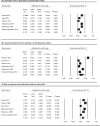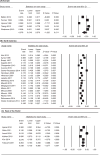Systematic review with meta-analysis: proximal disease extension in limited ulcerative colitis
- PMID: 28449361
- PMCID: PMC6350510
- DOI: 10.1111/apt.14063
Systematic review with meta-analysis: proximal disease extension in limited ulcerative colitis
Abstract
Background: Disease extent in ulcerative colitis is one of the major factors determining prognosis over the long-term. Disease extent is dynamic and a proportion of patients presenting with limited disease progress to more extensive forms of disease over time.
Aim: To perform a systematic review and meta-analysis of epidemiological studies reporting on extension of ulcerative colitis to determine frequency of disease extension in patients with limited ulcerative colitis at diagnosis.
Methods: We performed a systematic literature search to identify studies on disease extension of ulcerative colitis (UC) and predictors of disease progression.
Results: Overall, 41 studies were eligible for systematic review but only 30 for meta-analysis. The overall pooled frequency of UC extension was 22.8% with colonic extension being 17.8% at 5 years and 31% at 10 years. Extension was 17.8% (95% CI 11.2-27.3) from E1 to E3, 27.5% (95% CI 7.6-45.6) from E2 to E3 and 20.8% (95% CI 11.4-26.8) from E1 to E2. Rate of extension was significantly higher in patients younger than 18 years (29.2% (CI 6.4-71.3) compared to older patients (20.2% (CI 13.0-30.1) (P<.0001). Risk of extension was significantly higher in patients from North America (37.8%) than from Europe (19.6%) (P<.0001).
Conclusions: In this meta-analysis, approximately one quarter of patients with limited UC extend over time with most extension occurring during the first 10 years. Rate of extension depends on age at diagnosis and geographic origin. Predicting those at high risk of disease extension from diagnosis could lead to personalised therapeutic strategies.
© 2017 John Wiley & Sons Ltd.
Conflict of interest statement
Figures






Comment in
-
Editorial: does disease extension lead to disease progression in proctitis?Aliment Pharmacol Ther. 2017 Jul;46(2):205-206. doi: 10.1111/apt.14129. Aliment Pharmacol Ther. 2017. PMID: 28621077 No abstract available.
References
-
- Solberg IC, Lygren I, Jahnsen J, et al. Group IS Clinical course during the first 10 years of ulcerative colitis: results from a population-based inception cohort (IBSEN Study) Scand J Gastroenterol. 2009;44:431–440. - PubMed
-
- Ekbom A, Helmick C, Zack M, Adami HO. Ulcerative colitis and colorectal cancer. A population-based study. N Engl J Med. 1990;323:1228–1233. - PubMed
-
- Ekbom A, Helmick CG, Zack M, Holmberg L, Adami HO. Survival and causes of death in patients with inflammatory bowel disease: a population-based study. Gastroenterology. 1992;103:954–960. - PubMed
-
- Langholz E, Munkholm P, Davidsen M, Binder V. Colorectal cancer risk and mortality in patients with ulcerative colitis. Gastroenterology. 1992;103:1444–1451. - PubMed
Publication types
MeSH terms
Grants and funding
LinkOut - more resources
Full Text Sources
Other Literature Sources
Medical
